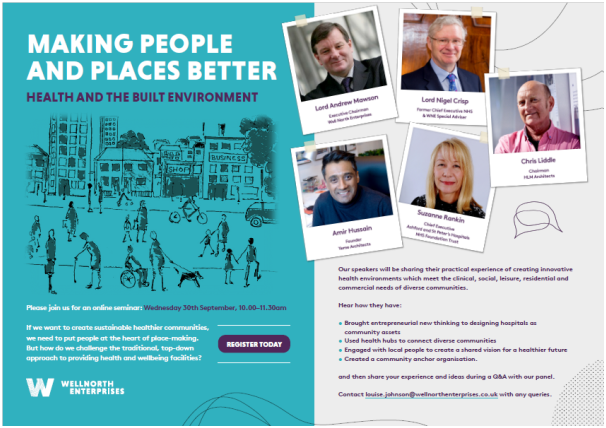Innovation in creating healthy people and places

New approaches to thinking about the purpose of hospitals and health facilities within a wider community setting is key to creating a healthy and resilient population, according to expert panellists at the ‘Making people and places better’ seminar hosted by Well North Enterprises (WNE).
Watch the event below.
Hosted by WNE Executive Chairman Lord Andrew Mawson, the virtual event brought together former NHS Chief Executive & Special Adviser to WNE Lord Nigel Crisp, leading architects Amir Hussain, founder of Yeme Architects, and Chris Liddle, chairman of HLM, plus Suzanne Rankin, Chief Executive of Ashford and St Peter’s Hospitals NHS Foundation Trust. The speakers shared their experience and the challenges they have faced in reshaping thinking about how we build a healthy and health-creating society
Lord Crisp said that while the NHS plays a vital role in treating ill-health, it is just one element of a three-part approach which also includes illness prevention and health creation. “I’ve visited many successful projects led by individuals with a vision which are creating healthier communities by focusing on purpose and relationships rather than systems and processes,” he said.
Amir Hussain shared his experience of taking a derelict public swimming pool and creating a vision for a community asset offering health, leisure, retail, business and social interaction opportunities, set in a welcoming green space within the Girlington neighbourhood of Bradford. “Our approach focuses on turning a monolithic building into a space for social connections, bringing together all the different organisations which have a stake in creating a healthier community,” explained Amir.
Making hospital services sustainable was the challenge for Suzanne Rankin and her team. They took a radical new approach, moving from keeping services within hospitals to becoming a community anchor organisation. “We really listened to what local people wanted and are collaborating with business, public and voluntary sector partners to think and act differently,” said Suzanne. “Changes like providing some outpatient appointments at a local gym have made a huge difference to our patients, staff and the wider community.”
Chris Liddle highlighted the benefits of treating the space within and around hospitals differently, so they become inspiring places both inside and out. “We need to understand what health facilities look like to the people who use them, and how we can design in ways of connecting people to opportunities to improve their wellbeing,” urged Chris. “They also need to be great environments for staff – we must look after the people who are providing the care for our communities.”
Lord Mawson then chaired a Q&A session which covered engaging with multiple stakeholders when designing new buildings, developing community relationships and resilience, using technology solutions in rural communities and how COVID-19 will impact on the design of both buildings and public green spaces.
Thanking the panellists and audience, Lord Mawson added: “We clearly need a radically different approach to delivering a healthier future for people, particularly in some of our most challenged communities. My own experience over 35 years is that bringing together the public sector, business partners and social entrepreneurs is the only way to generate sustainable change across communities. We need creative solutions to the underlying causes of ill-health – poverty, unemployment, poor housing, addiction or debt – things that won’t be fixed by a visit to the GP or A&E.
“We’ve got a once in a generation opportunity in this new COVID world for a complete rethink on how we approach health and wellbeing. Open dialogue and creative encounters across communities will help us to answer the question ‘what is a hospital in this century?’ far more effectively in the future.”
